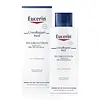What's inside
What's inside
 Key Ingredients
Key Ingredients

 Benefits
Benefits

 Concerns
Concerns

 Ingredients Side-by-side
Ingredients Side-by-side

Water
Skin ConditioningUrea
BufferingGlycerin
HumectantIsopropyl Stearate
EmollientDicaprylyl Ether
EmollientGlyceryl Glucoside
HumectantSodium Lactate
BufferingButyrospermum Parkii Butter
Skin ConditioningTapioca Starch
Polyglyceryl-4 Diisostearate/Polyhydroxystearate/Sebacate
EmulsifyingCarnitine
CleansingCetearyl Alcohol
EmollientCeramide NP
Skin ConditioningArginine Hcl
Skin ConditioningSodium PCA
HumectantHistidine
HumectantAlanine
MaskingCitrulline
Skin ConditioningLysine
Skin ConditioningSerine
MaskingLactic Acid
BufferingSodium Chloride
MaskingMannitol
HumectantSucrose
HumectantGlutamic Acid
HumectantThreonine
Glycogen
Humectant1,2-Hexanediol
Skin ConditioningPhenoxyethanol
PreservativePotassium Sorbate
PreservativeArginine
MaskingPCA
HumectantWater, Urea, Glycerin, Isopropyl Stearate, Dicaprylyl Ether, Glyceryl Glucoside, Sodium Lactate, Butyrospermum Parkii Butter, Tapioca Starch, Polyglyceryl-4 Diisostearate/Polyhydroxystearate/Sebacate, Carnitine, Cetearyl Alcohol, Ceramide NP, Arginine Hcl, Sodium PCA, Histidine, Alanine, Citrulline, Lysine, Serine, Lactic Acid, Sodium Chloride, Mannitol, Sucrose, Glutamic Acid, Threonine, Glycogen, 1,2-Hexanediol, Phenoxyethanol, Potassium Sorbate, Arginine, PCA
Water
Skin ConditioningAlcohol Denat.
AntimicrobialButyl Methoxydibenzoylmethane
UV AbsorberIsopropyl Palmitate
EmollientBis-Ethylhexyloxyphenol Methoxyphenyl Triazine
Skin ConditioningC12-15 Alkyl Benzoate
AntimicrobialDibutyl Adipate
EmollientDistarch Phosphate
AbsorbentDiethylamino Hydroxybenzoyl Hexyl Benzoate
UV FilterEthylhexyl Triazone
UV AbsorberButylene Glycol Dicaprylate/Dicaprate
EmollientPhenylbenzimidazole Sulfonic Acid
UV AbsorberDiethylhexyl Butamido Triazone
UV AbsorberGlycyrrhiza Inflata Root Extract
Skin ConditioningGlucosylrutin
AntioxidantIsoquercitrin
AntioxidantGlycyrrhetinic Acid
Skin ConditioningTocopherol
AntioxidantGlycerin
HumectantC18-38 Alkyl Hydroxystearoyl Stearate
EmollientCopernicia Cerifera Cera
EmollientHydrogenated Rapeseed Oil
EmollientCetyl Palmitate
EmollientMicrocrystalline Cellulose
AbsorbentXanthan Gum
EmulsifyingCellulose Gum
Emulsion StabilisingSodium Stearoyl Glutamate
CleansingSilica Dimethyl Silylate
EmollientPhenoxyethanol
PreservativeCaprylyl Glycol
EmollientHydroxyacetophenone
AntioxidantTrisodium EDTA
Sodium Hydroxide
BufferingSodium Chloride
MaskingWater, Alcohol Denat., Butyl Methoxydibenzoylmethane, Isopropyl Palmitate, Bis-Ethylhexyloxyphenol Methoxyphenyl Triazine, C12-15 Alkyl Benzoate, Dibutyl Adipate, Distarch Phosphate, Diethylamino Hydroxybenzoyl Hexyl Benzoate, Ethylhexyl Triazone, Butylene Glycol Dicaprylate/Dicaprate, Phenylbenzimidazole Sulfonic Acid, Diethylhexyl Butamido Triazone, Glycyrrhiza Inflata Root Extract, Glucosylrutin, Isoquercitrin, Glycyrrhetinic Acid, Tocopherol, Glycerin, C18-38 Alkyl Hydroxystearoyl Stearate, Copernicia Cerifera Cera, Hydrogenated Rapeseed Oil, Cetyl Palmitate, Microcrystalline Cellulose, Xanthan Gum, Cellulose Gum, Sodium Stearoyl Glutamate, Silica Dimethyl Silylate, Phenoxyethanol, Caprylyl Glycol, Hydroxyacetophenone, Trisodium EDTA, Sodium Hydroxide, Sodium Chloride
 Reviews
Reviews

Ingredients Explained
These ingredients are found in both products.
Ingredients higher up in an ingredient list are typically present in a larger amount.
Glycerin is already naturally found in your skin. It helps moisturize and protect your skin.
A study from 2016 found glycerin to be more effective as a humectant than AHAs and hyaluronic acid.
As a humectant, it helps the skin stay hydrated by pulling moisture to your skin. The low molecular weight of glycerin allows it to pull moisture into the deeper layers of your skin.
Hydrated skin improves your skin barrier; Your skin barrier helps protect against irritants and bacteria.
Glycerin has also been found to have antimicrobial and antiviral properties. Due to these properties, glycerin is often used in wound and burn treatments.
In cosmetics, glycerin is usually derived from plants such as soybean or palm. However, it can also be sourced from animals, such as tallow or animal fat.
This ingredient is organic, colorless, odorless, and non-toxic.
Glycerin is the name for this ingredient in American English. British English uses Glycerol/Glycerine.
Learn more about GlycerinPhenoxyethanol is a preservative that has germicide, antimicrobial, and aromatic properties. Studies show that phenoxyethanol can prevent microbial growth. By itself, it has a scent that is similar to that of a rose.
It's often used in formulations along with Caprylyl Glycol to preserve the shelf life of products.
Chances are, you eat sodium chloride every day. Sodium Chloride is also known as table salt.
This ingredient has many purposes in skincare: thickener, emulsifier, and exfoliator.
You'll most likely find this ingredient in cleansers where it is used to create a gel-like texture. As an emulsifier, it also prevents ingredients from separating.
There is much debate on whether this ingredient is comedogenic. The short answer - comedogenic ratings don't tell the whole story. Learn more about comegodenic ratings here.
The concensus about this ingredient causing acne seems to be divided. Research is needed to understand if this ingredient does cause acne.
Scrubs may use salt as the primary exfoliating ingredient.
Learn more about Sodium ChlorideWater. It's the most common cosmetic ingredient of all. You'll usually see it at the top of ingredient lists, meaning that it makes up the largest part of the product.
So why is it so popular? Water most often acts as a solvent - this means that it helps dissolve other ingredients into the formulation.
You'll also recognize water as that liquid we all need to stay alive. If you see this, drink a glass of water. Stay hydrated!
Learn more about Water